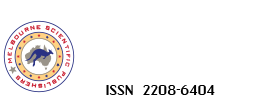



Authors can submit their manuscript by sending it through mail to the respective journal’s Editor In-Chief email address Submit your paper through online www.aujst.com/submit-article.php [or] mail to editorausjst@gmail.com Each submitted manuscript will be provided with a Manuscript Reference Number and all correspondence is done through e-mail. Please always refer to the manuscript reference number for any further enquiries/clarification.
All authors are requested to send their articles according to the given journal format mentioned in the guidelines for authors. Melbourne scientific publisher’s publishes the following manuscript types:
a single Word file with tables and figures according journal format and each figures and tables should be clearly labeled.
The language of the journal is English. Please ensure that your manuscript has been checked by an English language expert if there is concern for grammatical or other errors. All submissions including book reviews must have a title, be double-line spaced with type no smaller than 12 point, and have a margin of 3cm all round. Tables must be on separate pages after the reference list, and not be incorporated into the main text. Figures should be uploaded as separate Image files.
The Title page should contain the Title with concise and as informative as possible , the name(s) of the author(s), the name(s) and address (es) of the institution(s) where the work was carried out, including a valid e-mail address for each author listed in the manuscript. Corresponding author should provide full contact information, including phone number and email address. Authors must provide short version of title to attract scientific community. Three to seven key terms that are not in the title should also be included on the title page.
The Abstract should summarize concisely in no more than 250 words, the rationale, main findings, main conclusions, and wider implications of the study. This should be understandable without citations to the rest of the paper.
Authors are encouraged to provide a self-explanatory graphical abstract of the manuscript and it should be included next to abstract section. In addition, authors may include highlights of the core findings at least 3 bullet points in graphical abstract section.
This section should be short and informative without any subheadings. In this section authors should provide background that puts the manuscript into context and allows readers outside the field to understand the purpose and significance of the study. Provide the objective of present work and other relevant information.
This part should be presented with clarity and detail. Authors should provide sufficient information with regards to all procedures with proper citations. It can be divided into various subsections based on the experimental design.
Conclusion section should more concise without any references. This section should emphasis on importance of present work, conclusion (should not summarize the work) and future directions.
List of all financial/material support and scientific experts who all are involving in this work and provided scientific ideas.
Tables should be in continuation with text, and should be numbered with a concise and descriptive legend. They should be included in the text of content in a sequential order.
Each figure should be inserted along with text where appropriate and labeled accordingly.
The correctness of the cited references and other relevant information is the responsibility of the all authors.
Example: Qing D, Duan F, Wang Z. Natural products for health. J Nat Prod Biomed Res, 2017, 1, 1-12.
Books: Qing D, Duan F, Wang Z. Natural products for health. Ed, Vol XX, Publisher, City, year, page numbers.
Citation in the text is by author and year.
Examples:
Authors must be included the ethical committee approval for experimental design in the Materials and Methods section.
Author(s) are fully responsible for the content and originality of manuscript. After the publication, any concern regarding the published manuscript, Editorial board members have the rights to withdraw the written/published research work before/after publication.
All submitted manuscripts will be subjected to confidential peer review by experts as well as editorial board team members in the concern research field and, on the basis of reviewers comments/suggestions, manuscripts will be accepted unaltered, accepted subject to revision or rejected. Confirmation about the acceptance/revision and rejection of the manuscript will be sent to e-mail address of the corresponding author.
Authors are required to submit, with the manuscript, the names, addresses and e-mail addresses of 3-5 potential referees. Finally, editors have rights to select the reviewer’s name for manuscript review process. A peer review system involving minimum two reviewers will be used to confirm quality of manuscripts for publication in the journal.
Authors must be signed copyright form and finally send to Editor In-Chief to start the publication process of accepted manuscripts.
All the accepted manuscripts send to production to prepare galley proofs and then final Galley proofs sent to the corresponding author through email. Galley proofs are returned to Editor In-Chief or concern responsible person within 5 days of receipt. After the receipt of mail from authors regarding galley corrections, production department will start the publication of manuscript. All published manuscripts will be intimated through appropriate corresponding author email.
All authors of must disclose any and all conflicts of interest with the publication.
Total number of issues of the journal is 4 per year [Quarterly]
For institutions in Australia : AUD 50 per article
Foreign countries: $50 per article
Volume-9 Issue-2
Paper Submission : 28-Feb 2026
Author Notification : After Review
Issue Publication : 30-March 2026
Frequency : Quarterly